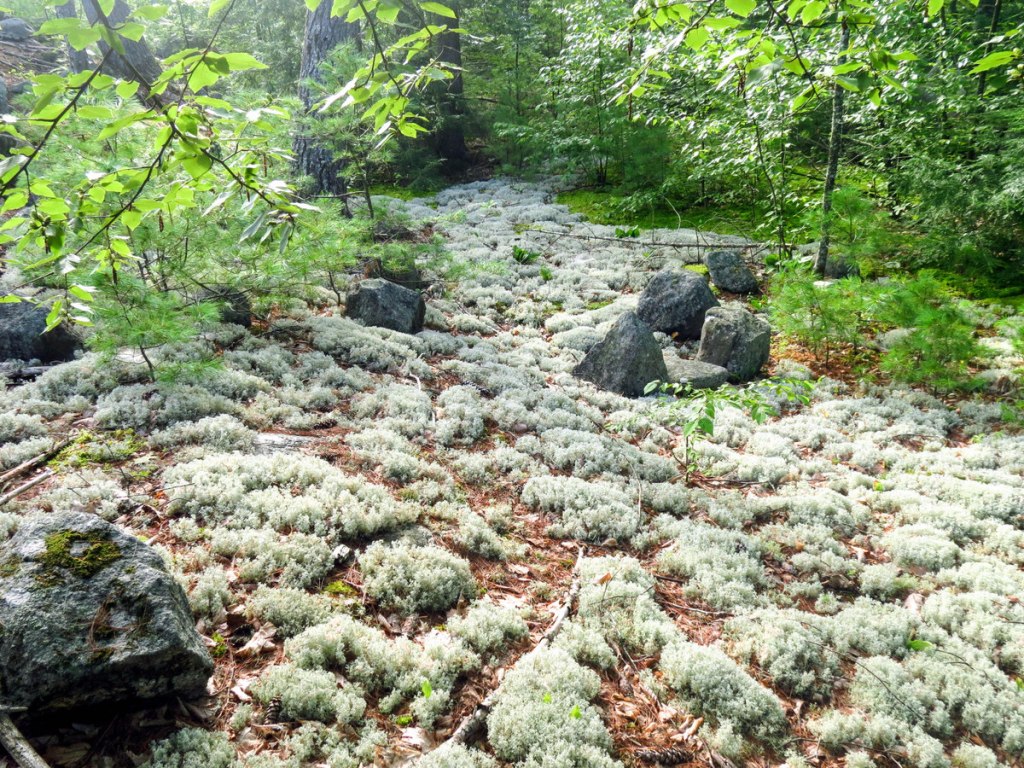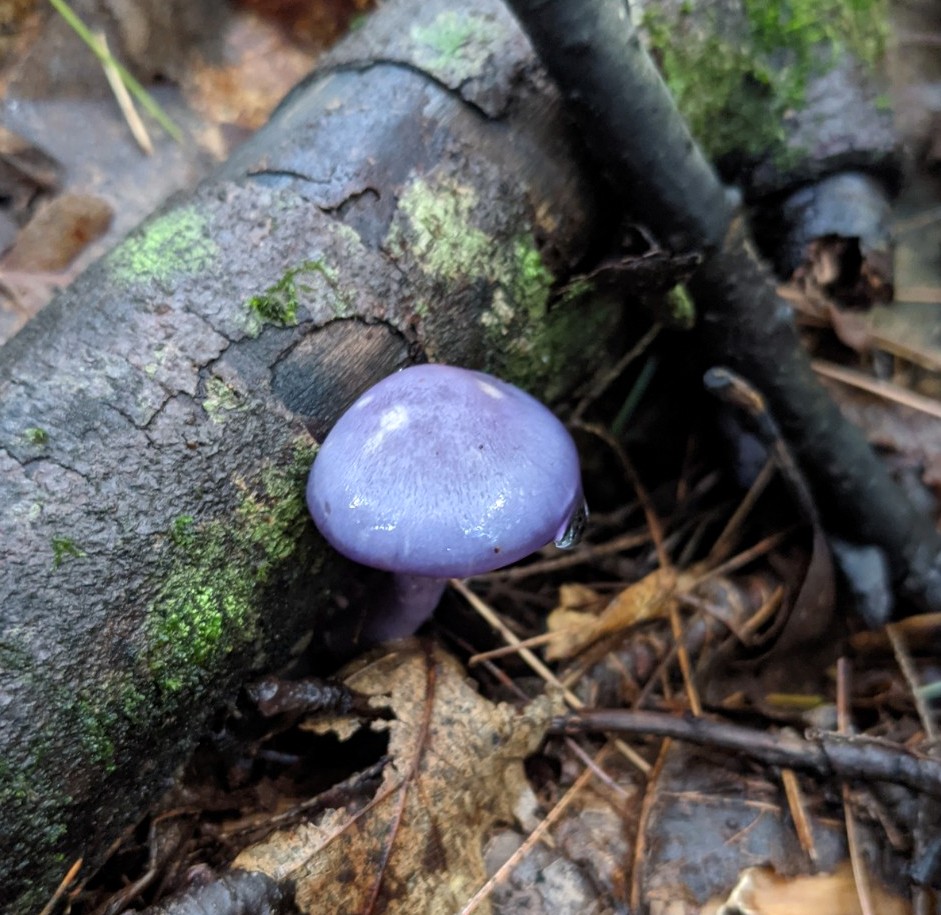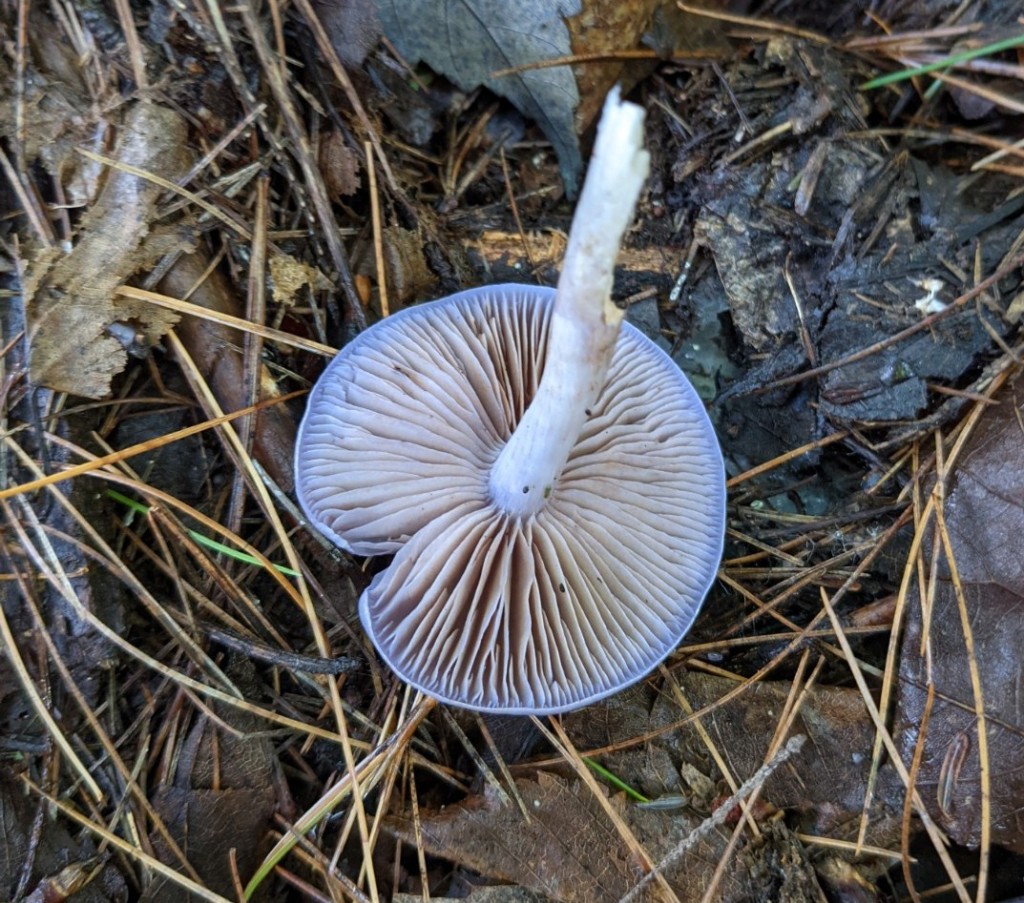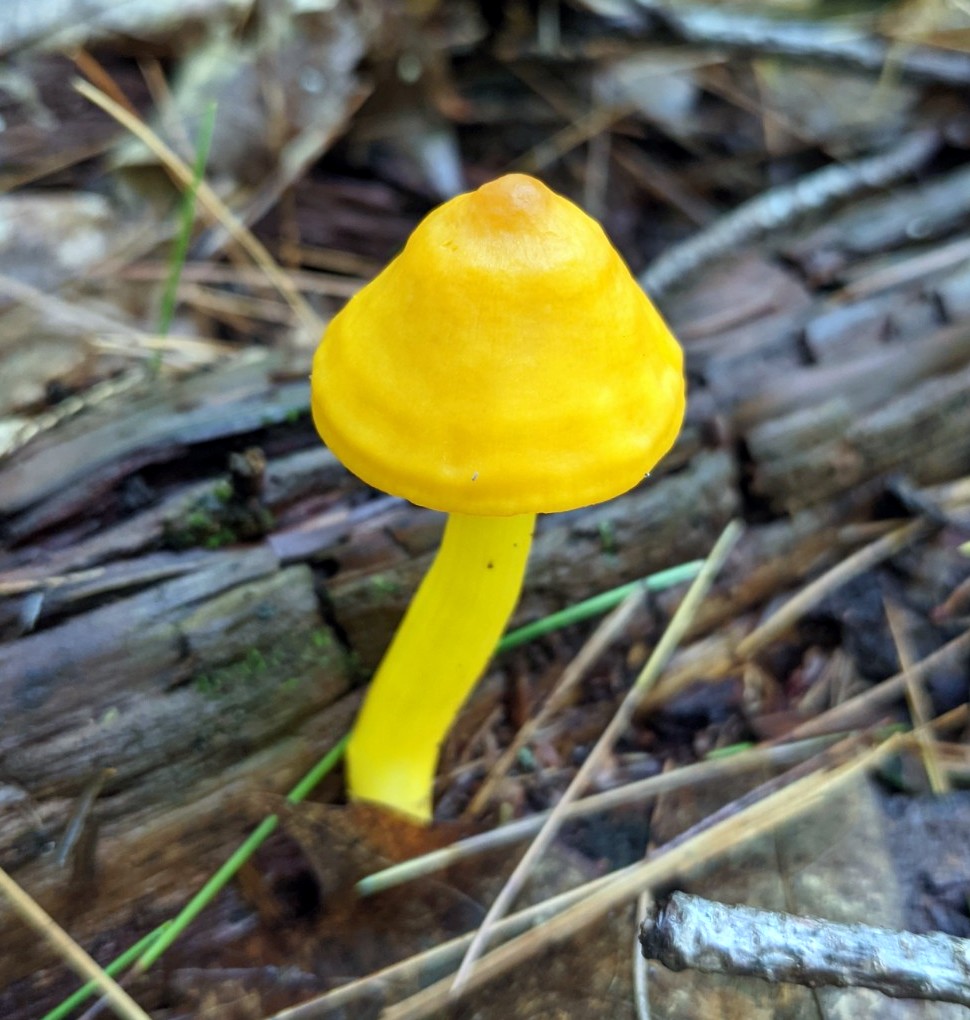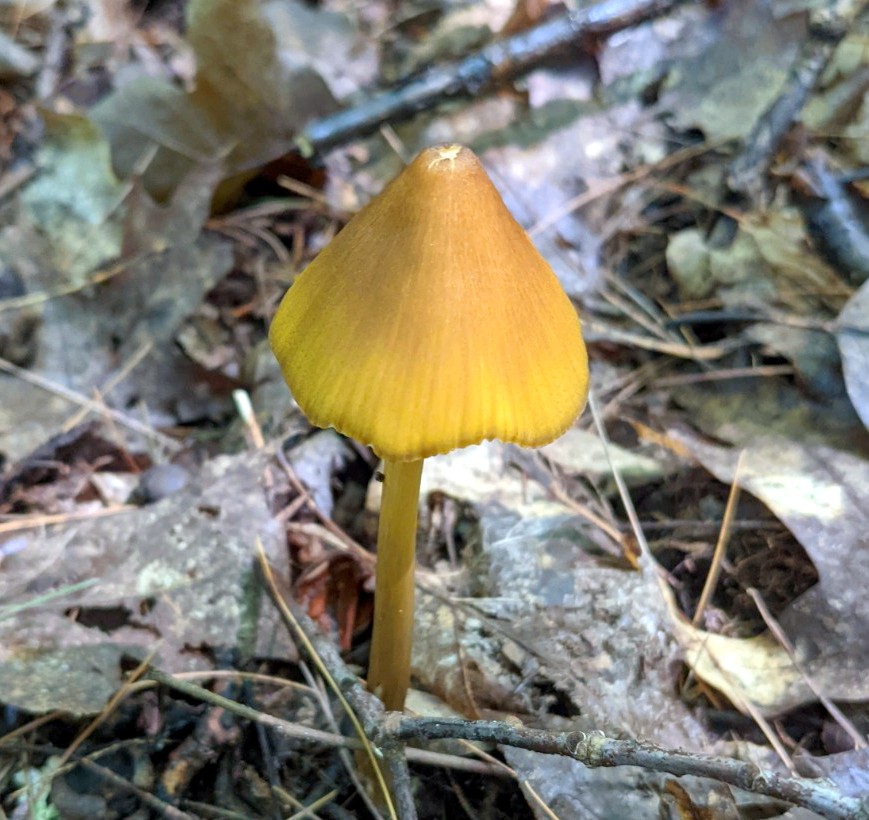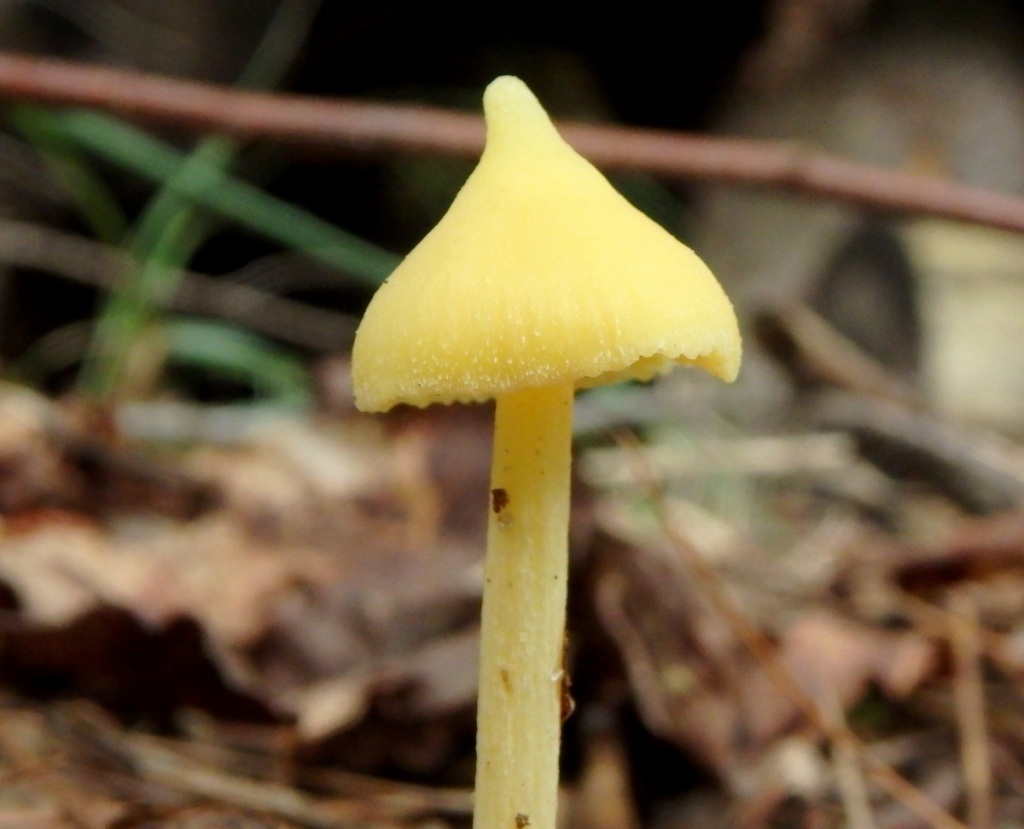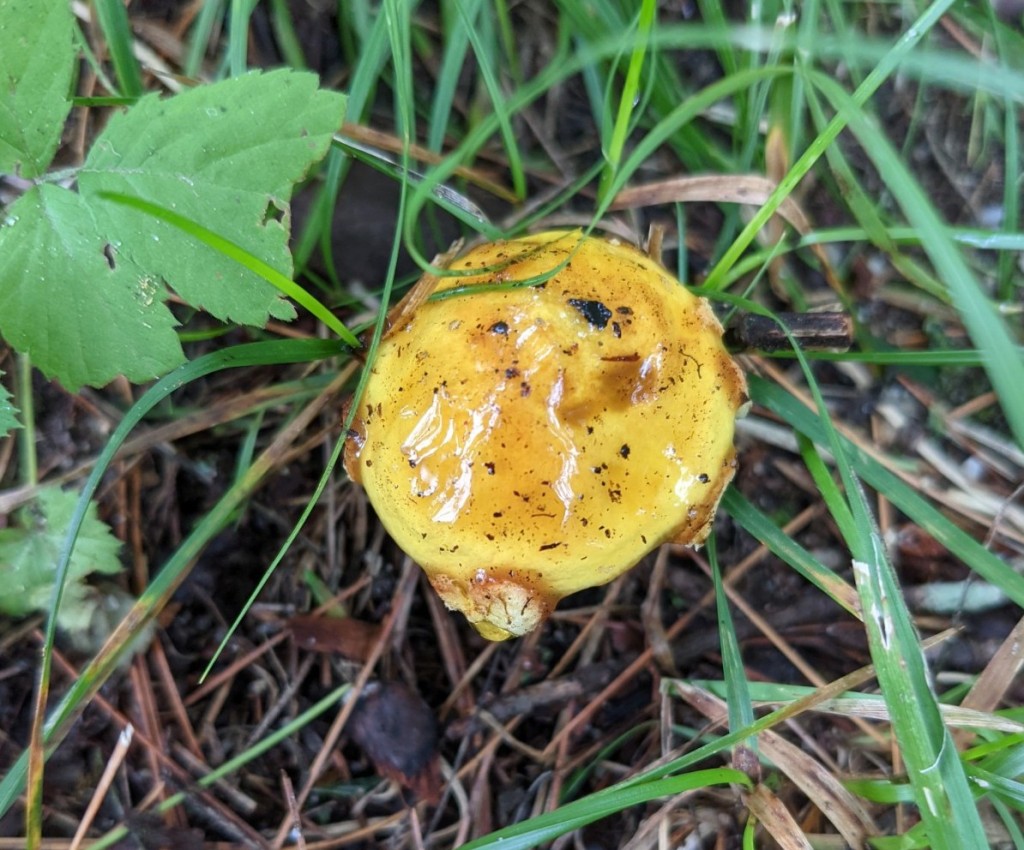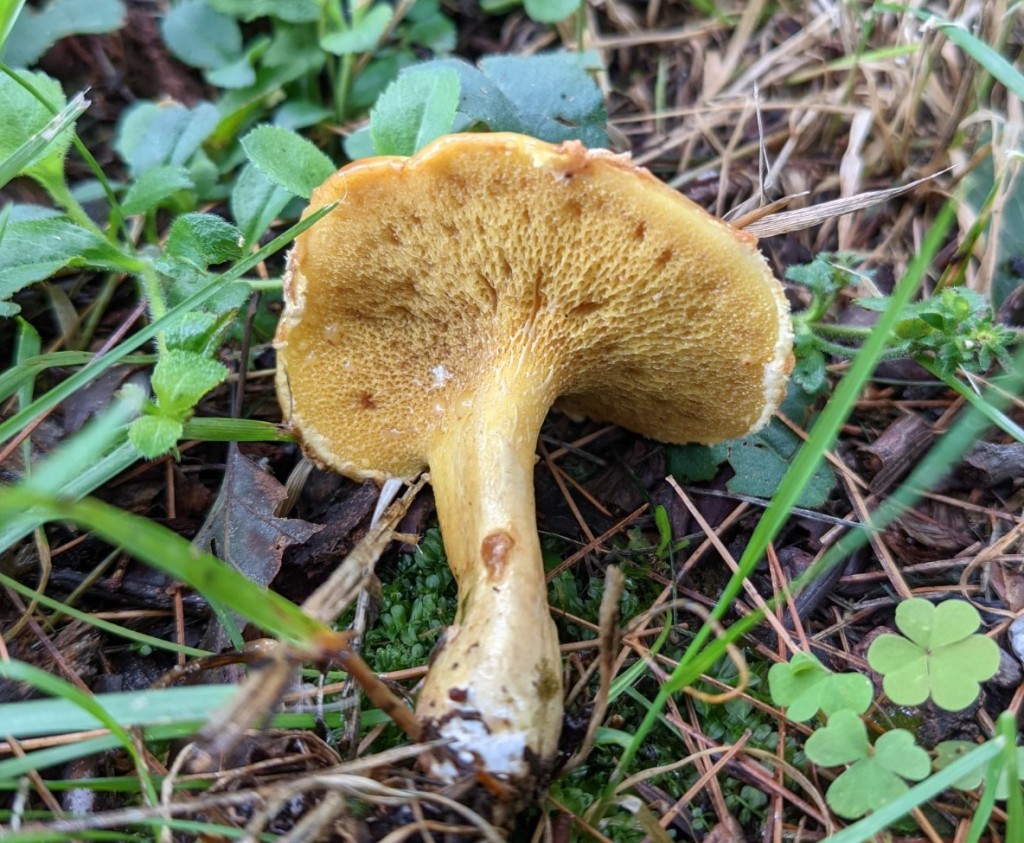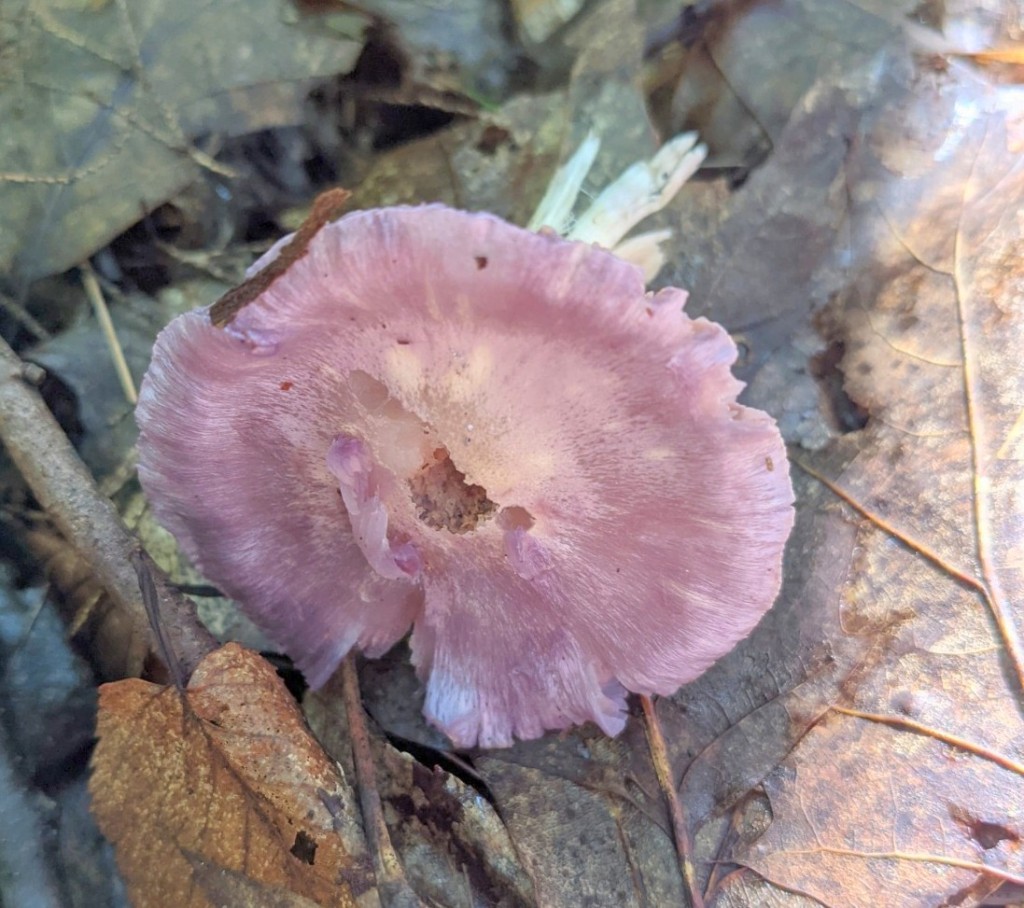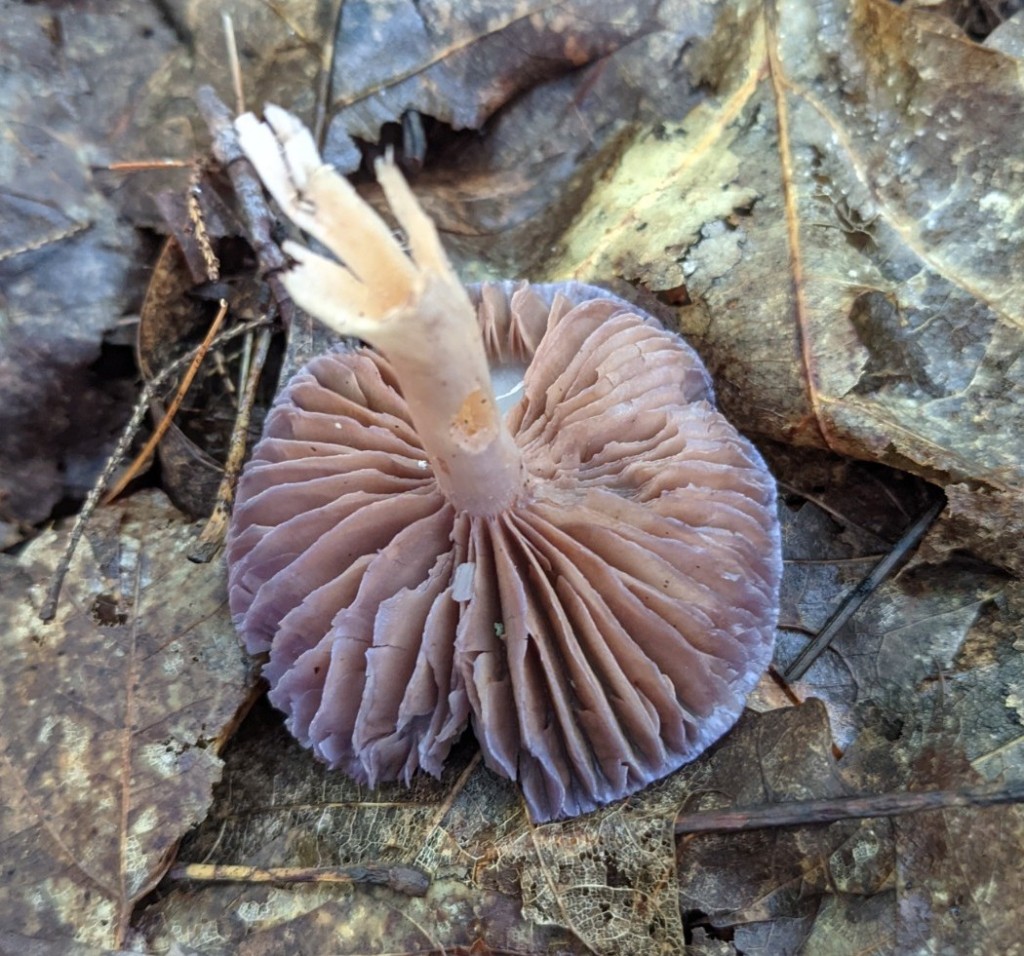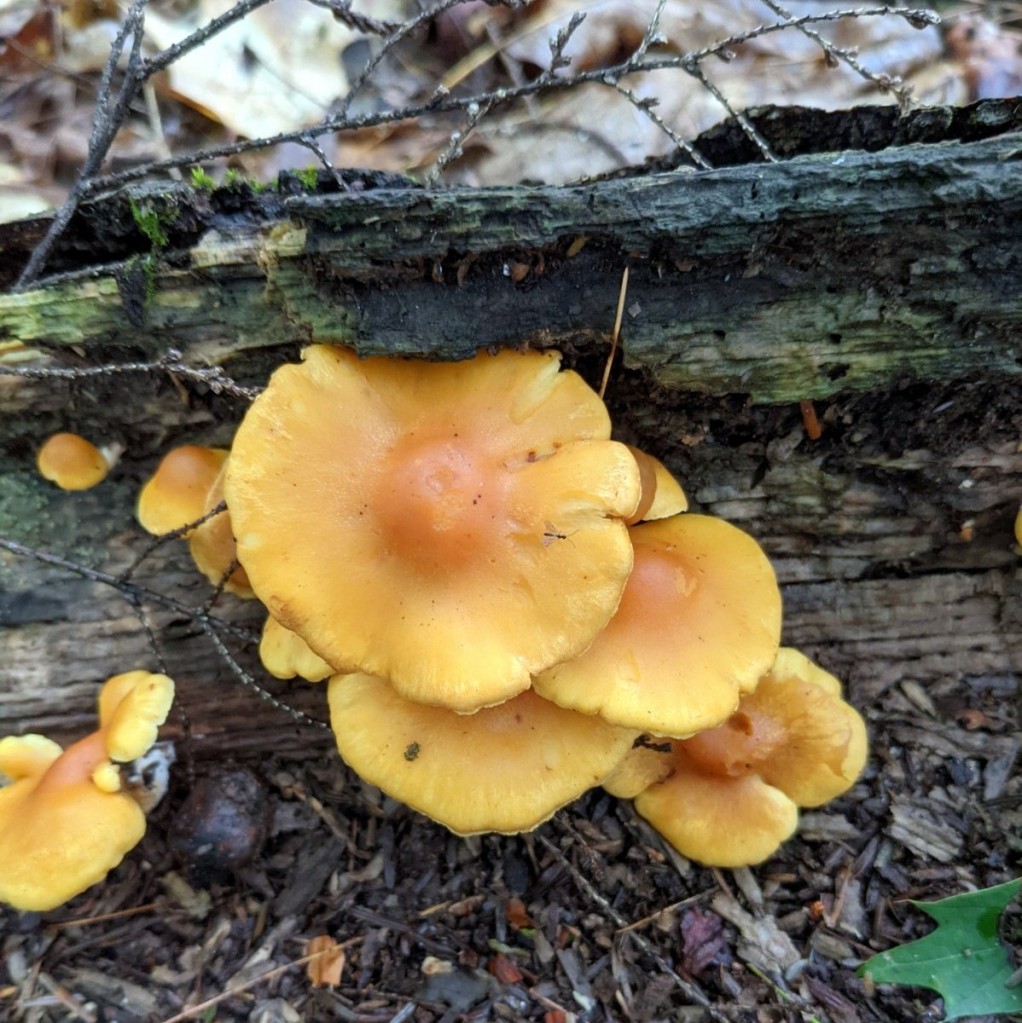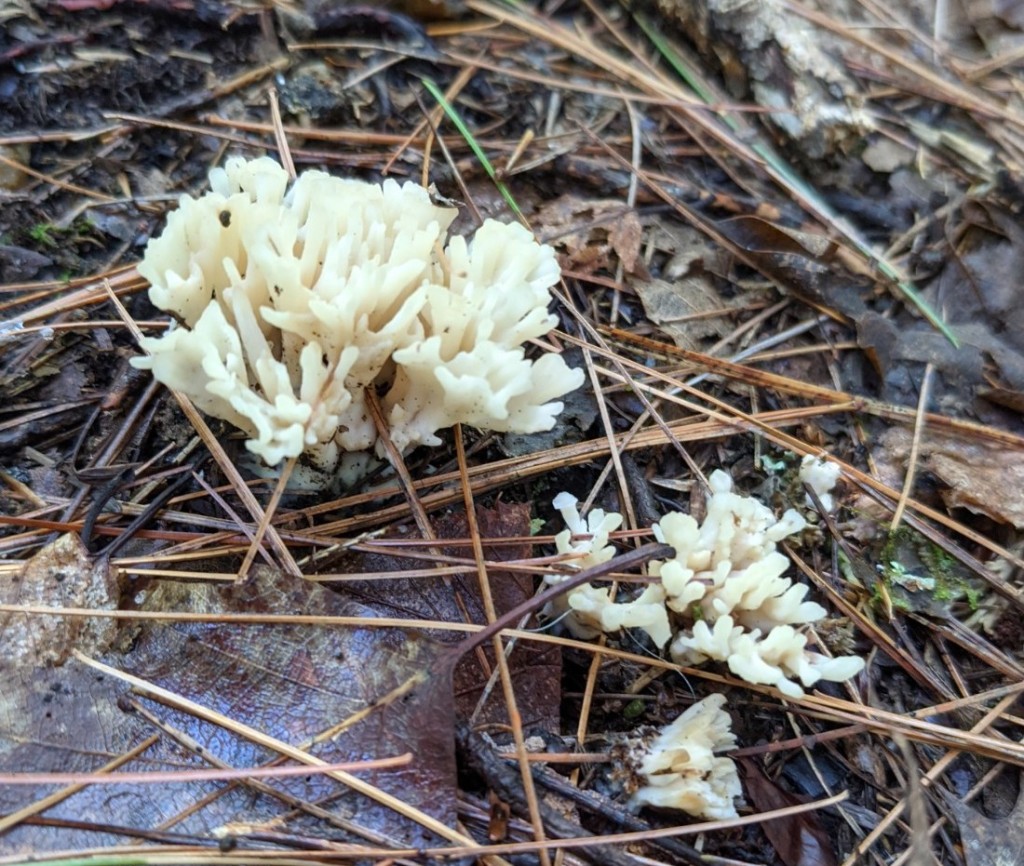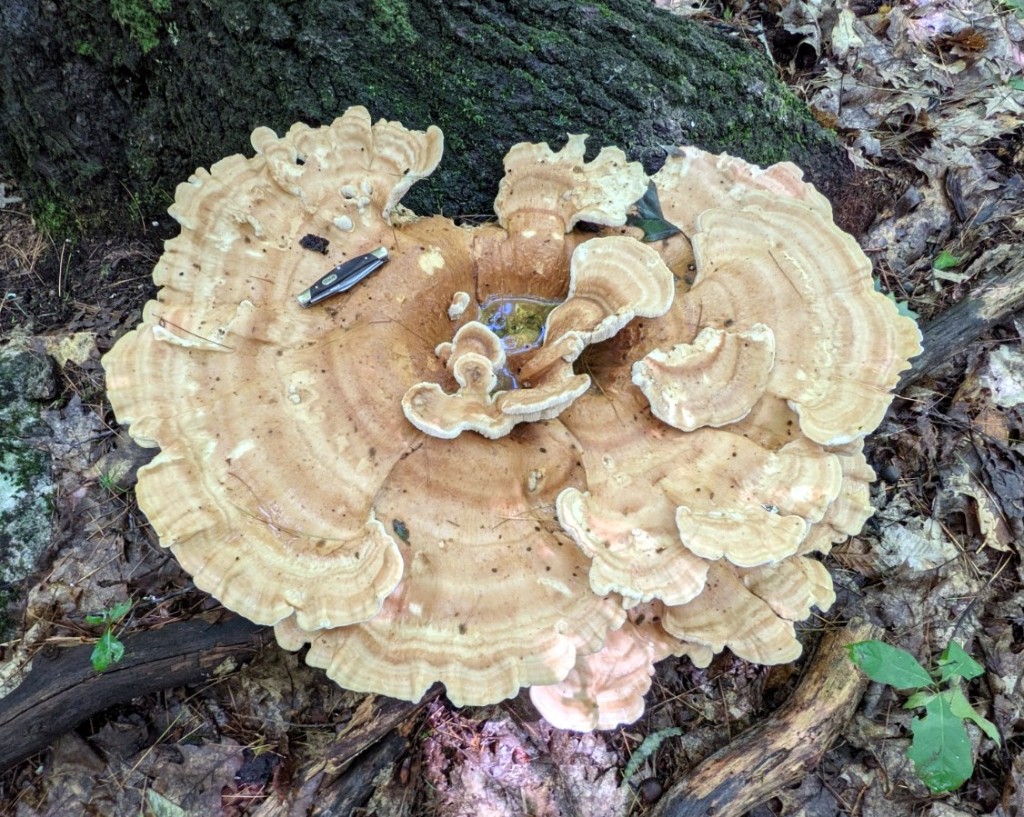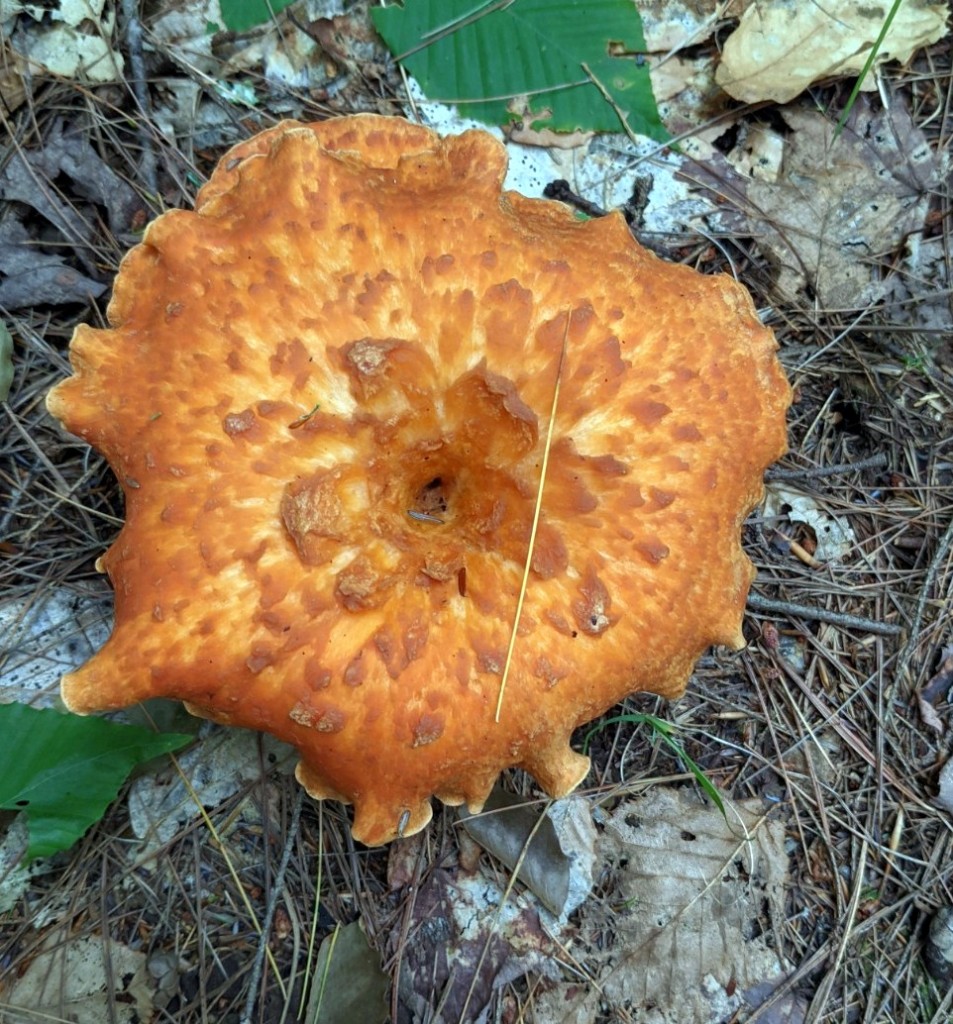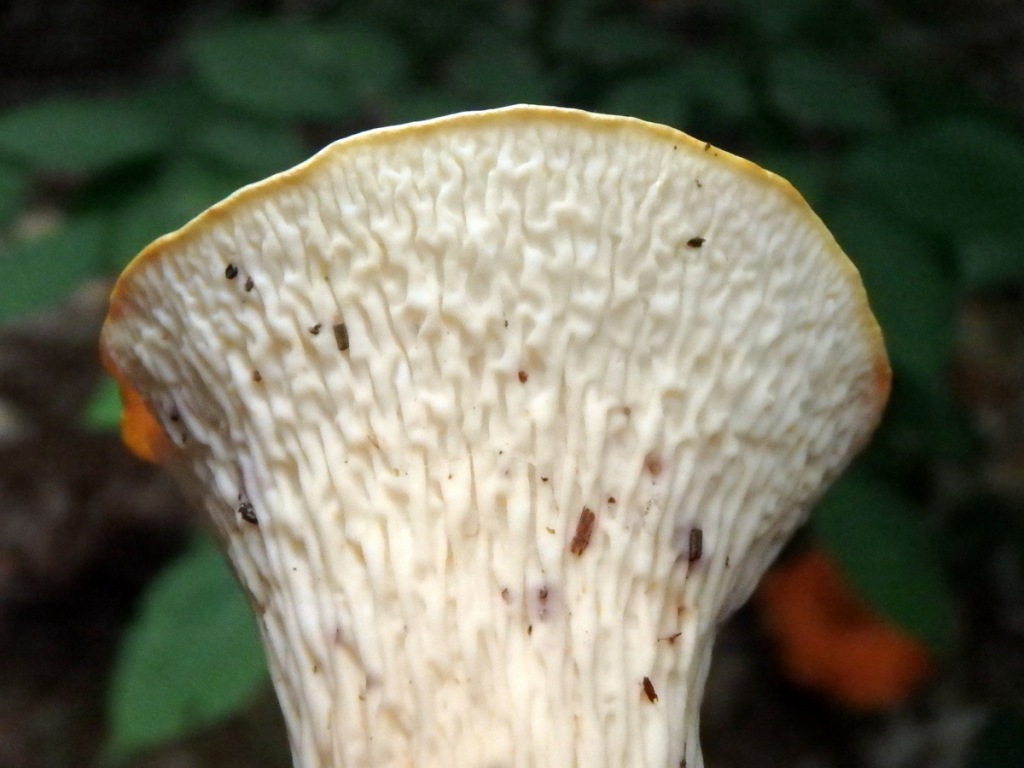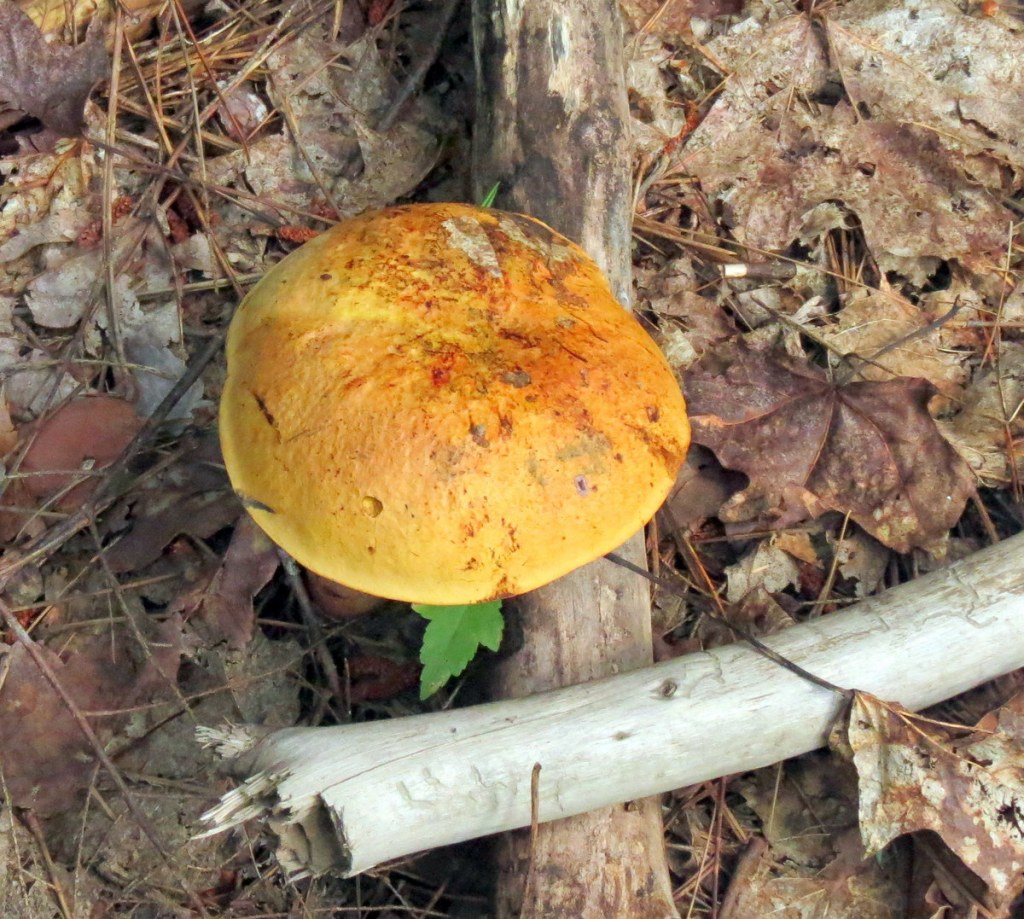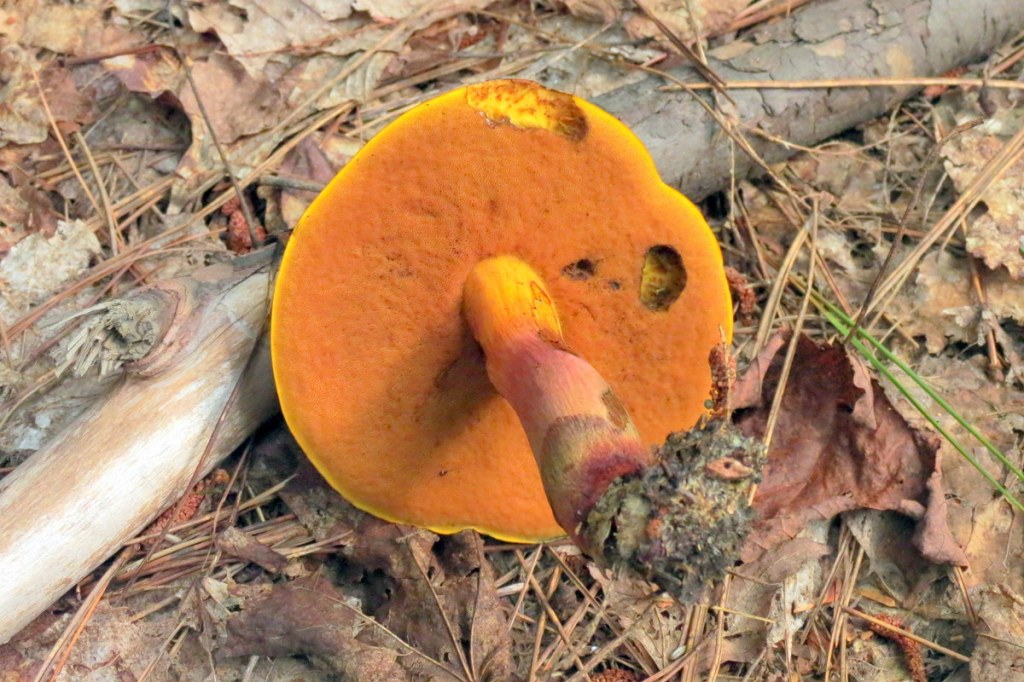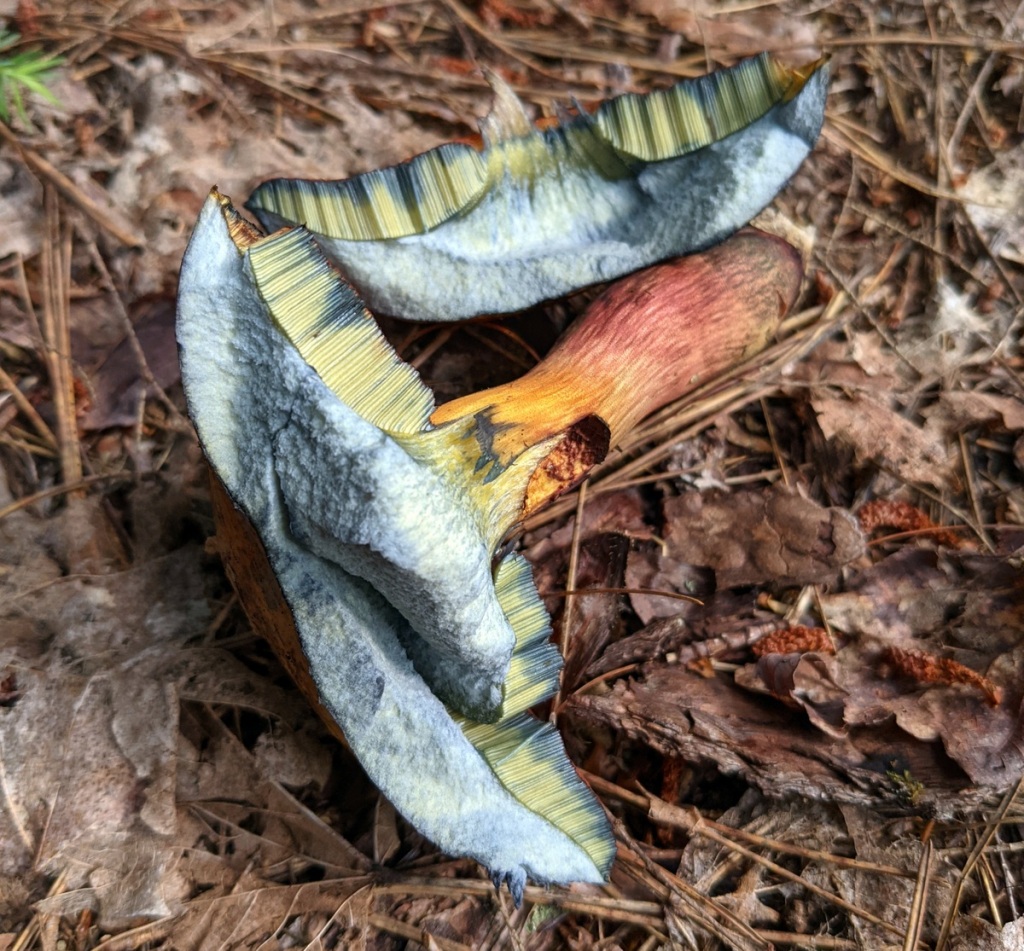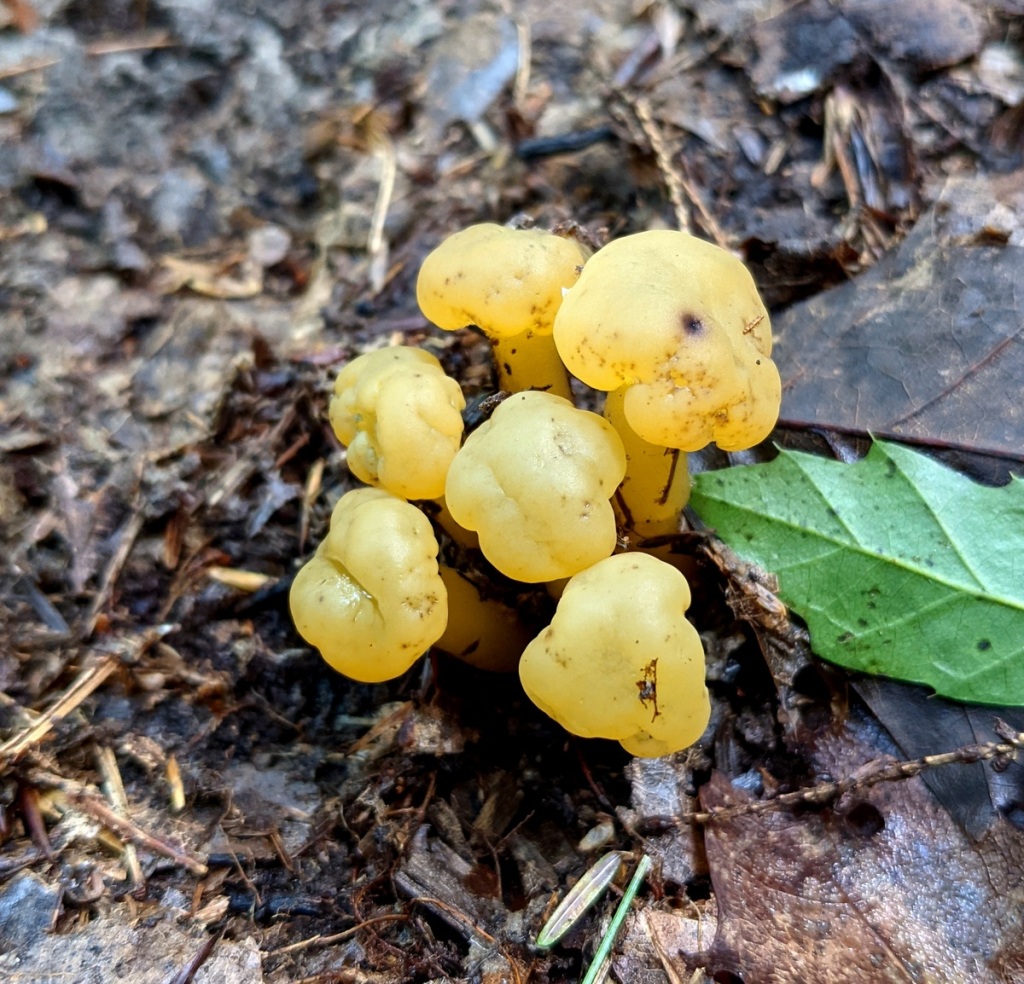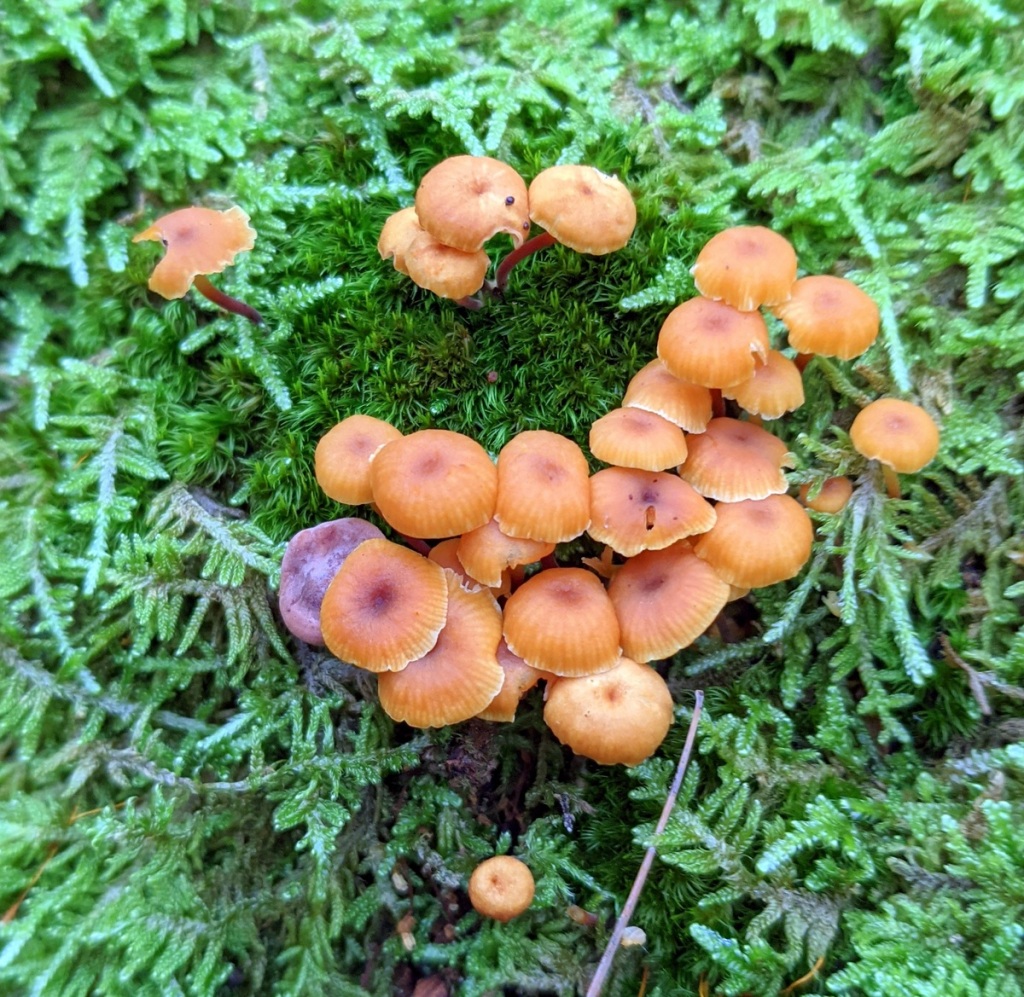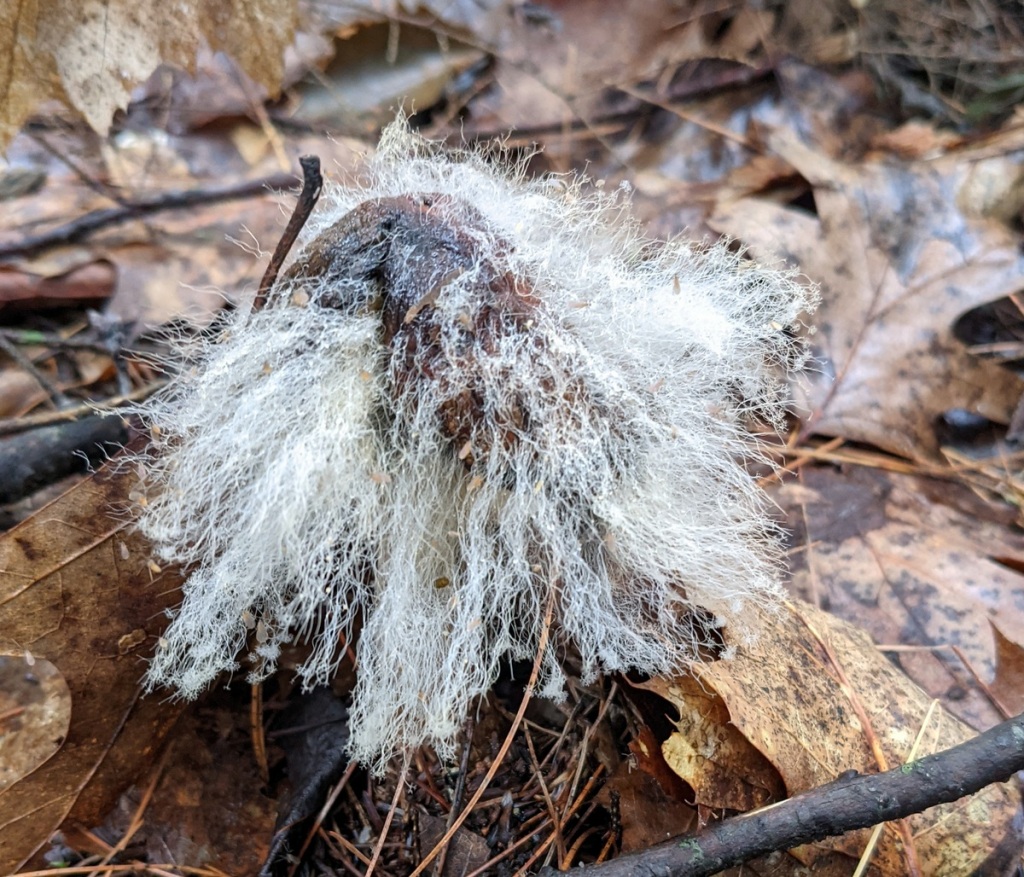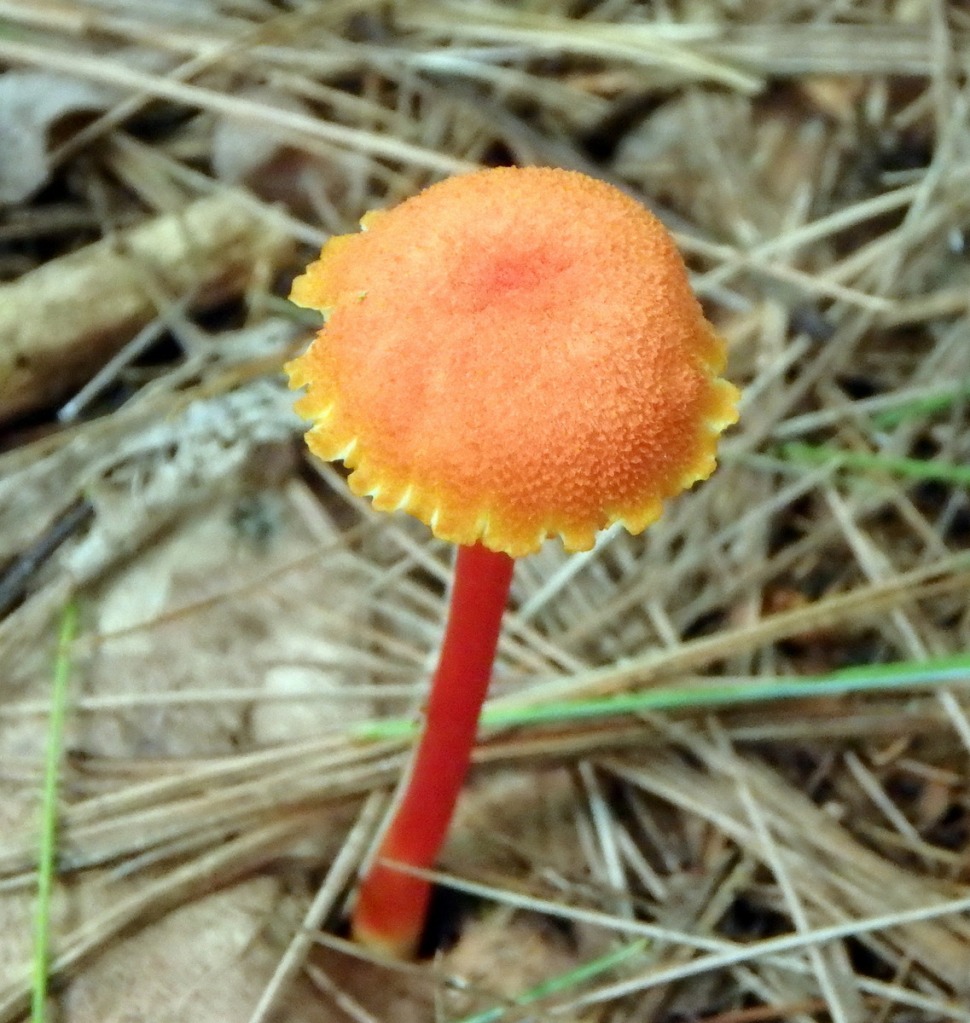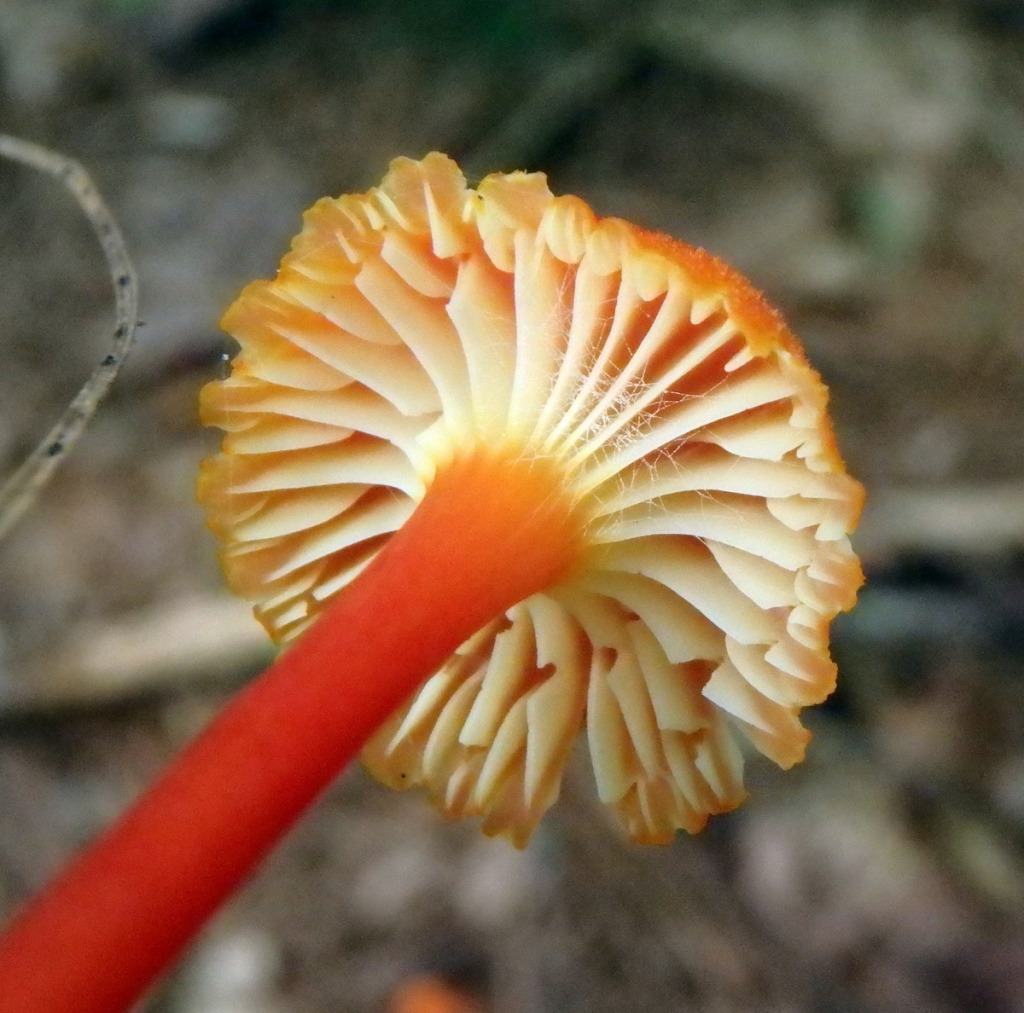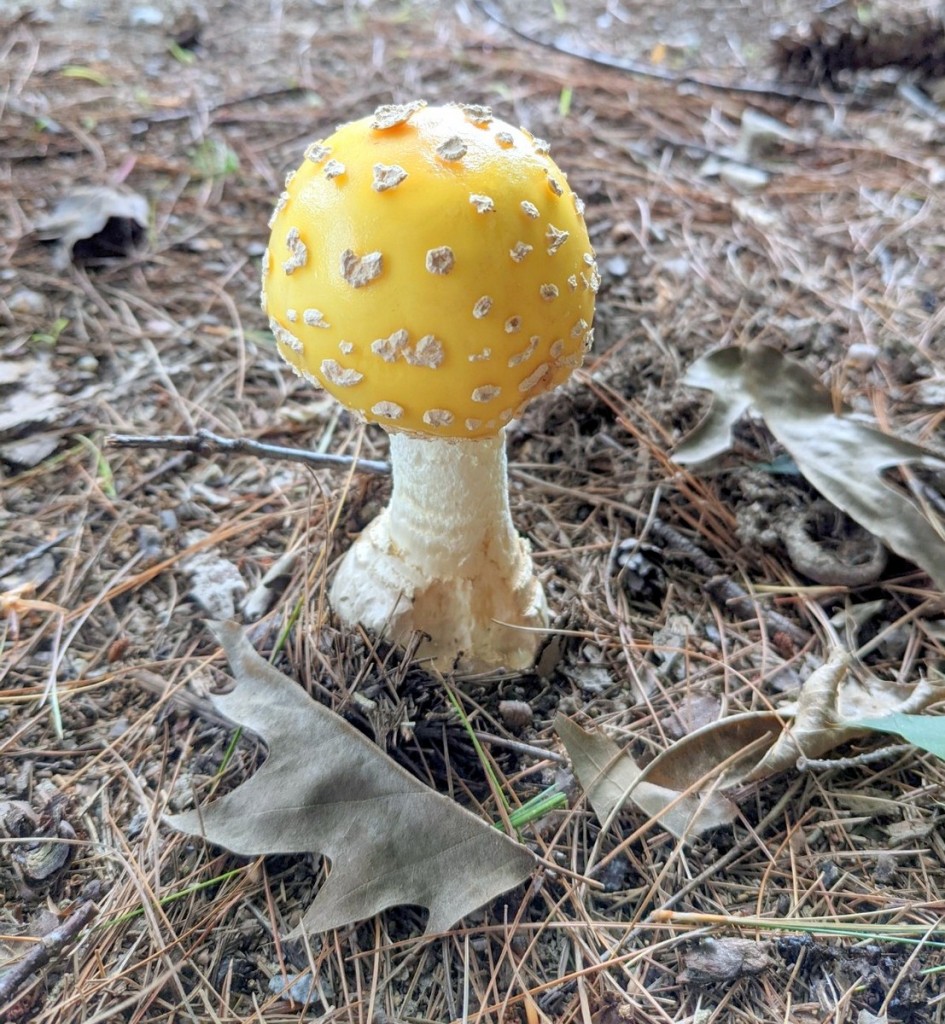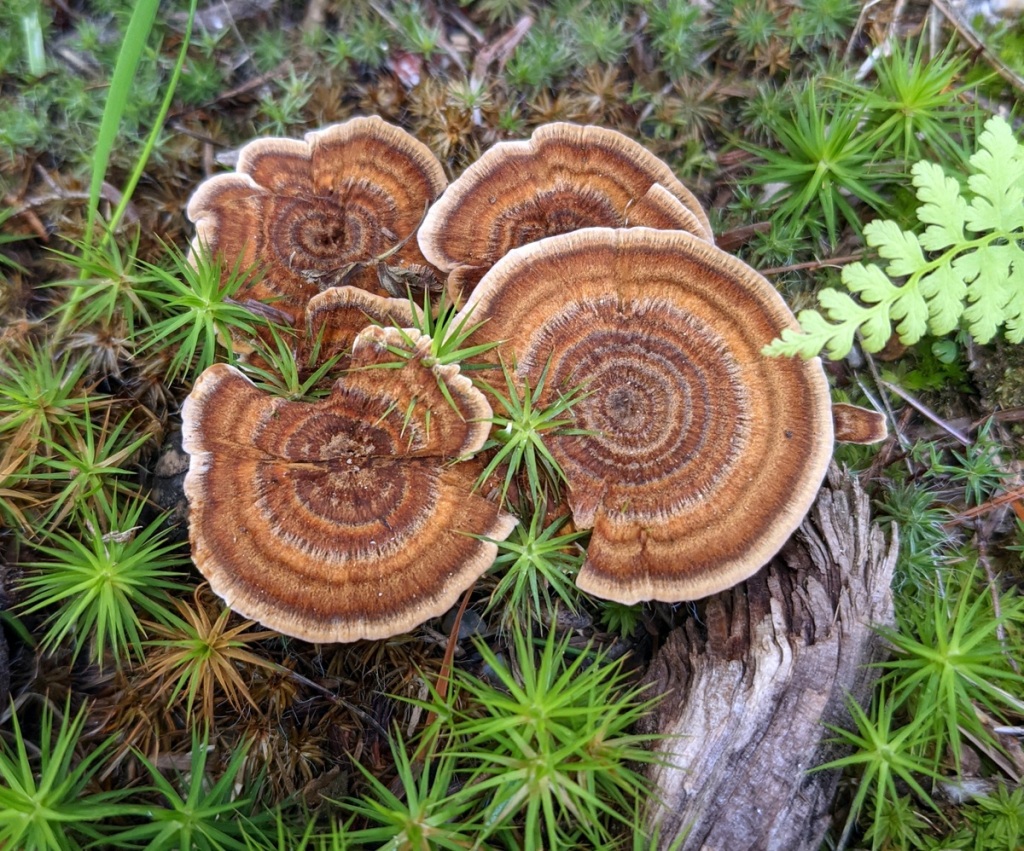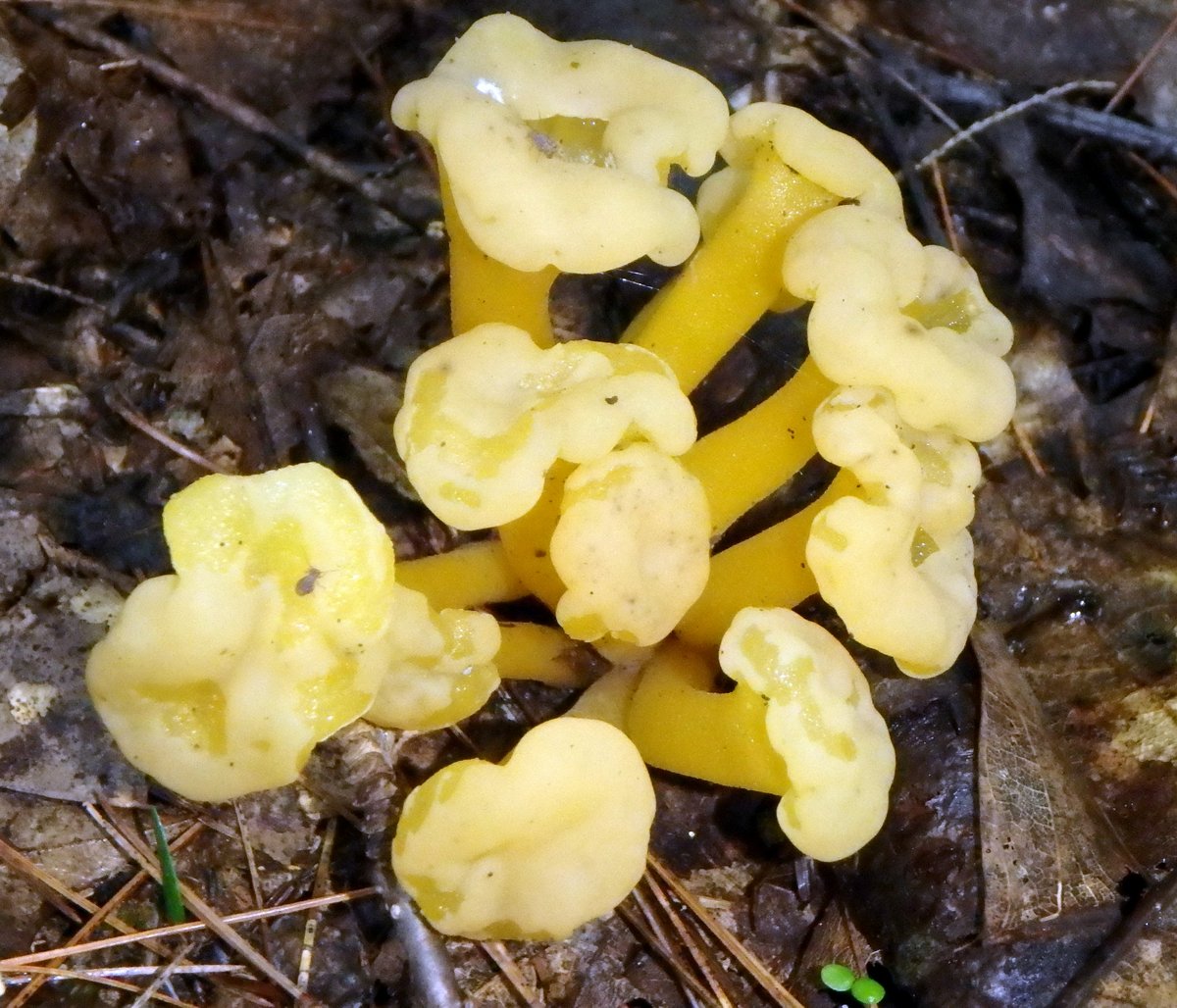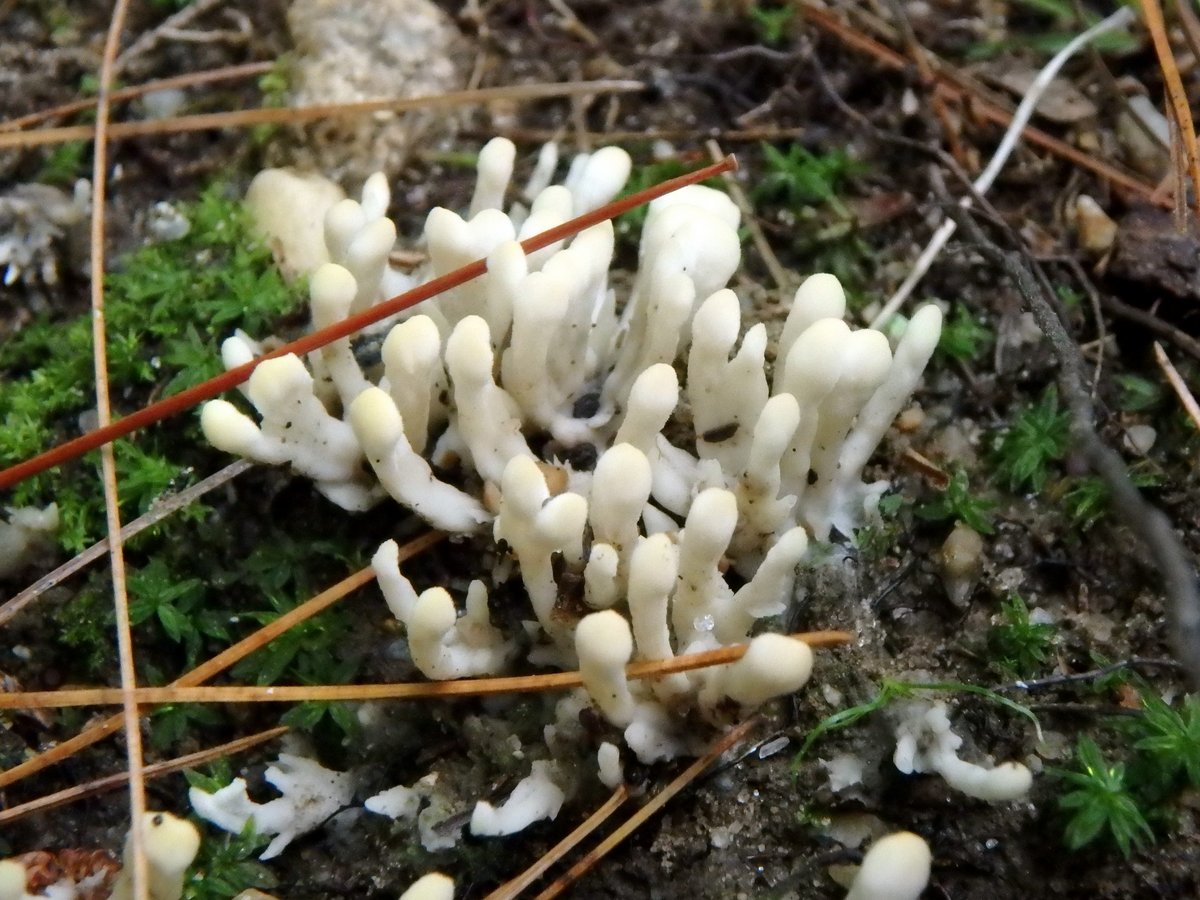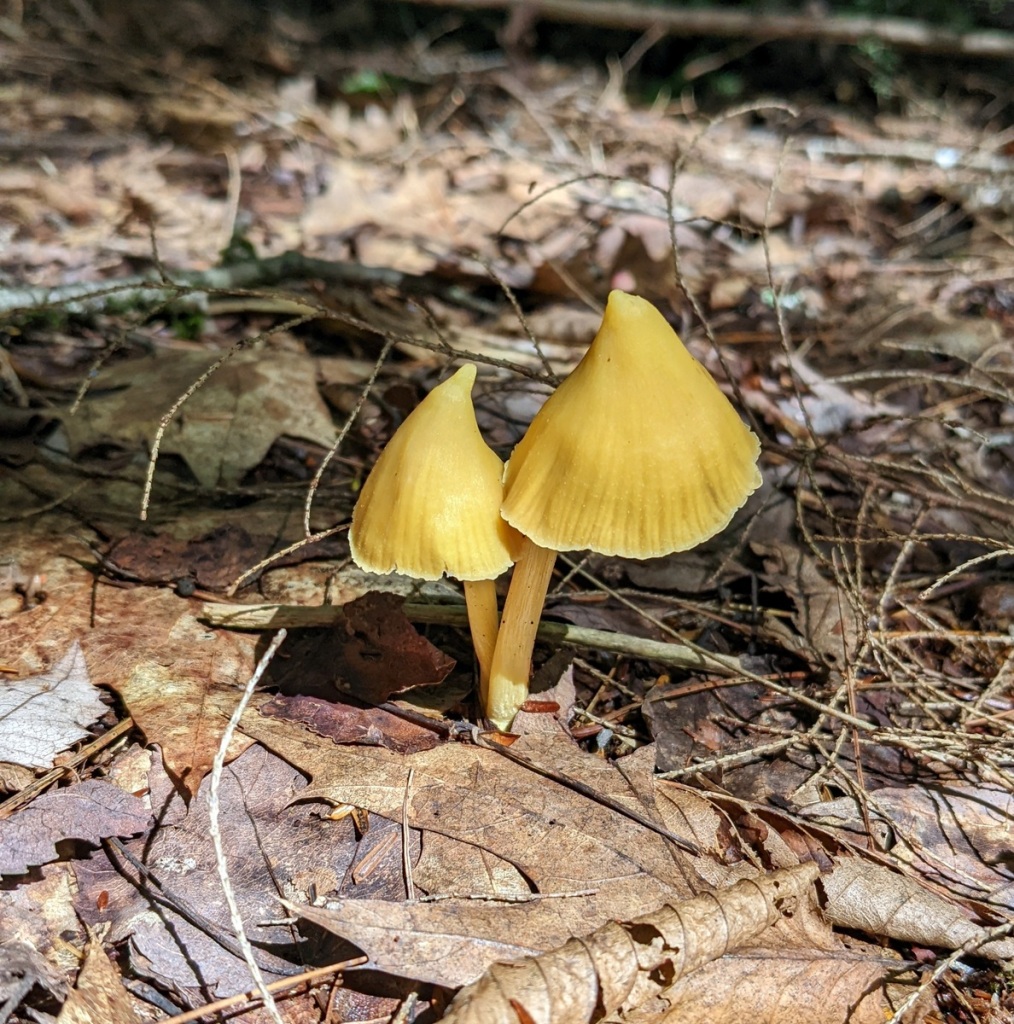
I’ve had a hard time getting to this mushroom post because so many other things have been showing themselves, but things are calming down now so I’ve finally put this one together. I say finally because I found most of what you’ll see here in August when it rained frequently for a week or so. I’m starting of with these cute little orange unicorn mushrooms (Entoloma quadratum.) Though I don’t see any orange in them my color finding software does, so I believe the name is correct. The unicorn part of the name comes from the tiny knob at the top of the cap. These mushrooms aren’t common here but I see a handful each year.

I’ve seen lots of coral fungi lately, especially yellow spindle coral (Clavulinopsis fusiformis) like that seen here. They always remind me of tiny flames coming up out of the earth. I often see them coming up along the sides of hard packed trails.

Quite often when looking for mushrooms you’ll find at least one that can’t be identified and this is one of those. You have to look at branching or forking and tip formation in coral fungi but there was very little of either going on here so all I can say is it’s a type of club or finger coral. At first I thought they were a worm coral but a close look showed a bit of branching going on.

Purple cort mushrooms (Cortinarius iodeoides) are covered with a bitter slime that keeps critters from damaging them. I’ve tried unsuccessfully for years to get a photo of the slime so I could show it to you. This year I finally pulled it off; you can see the liquid like reflections on this cap, though there isn’t really any liquid there. If you picked it you would find it cold and slimy; that’s the only way to describe it. The slime does dry as they age and then slugs will start eating them.

Butter wax caps (Hygrocybe ceracea) are usually one of the most photogenic of all the smaller mushrooms but these were ragged, and I’m not sure why. I didn’t see any real good examples of how beautiful this mushroom can be this year.

I saw just a single hen of the woods mushroom (Grifola frondosa) this year and this is it. It was young and not well developed but it was interesting just the same. They are also called ram’s head or sheep’s head in this country and in Japan they are known as the dancing mushroom. They are said to look like the back of a brown hen’s ruffled feathers, and that’s how they come by their common name. I’m a little baffled by mushrooms this year. We had more rain than I can remember so I thought there would be mushrooms everywhere, but that hasn’t been the case. Can we have too much rain even for mushrooms?
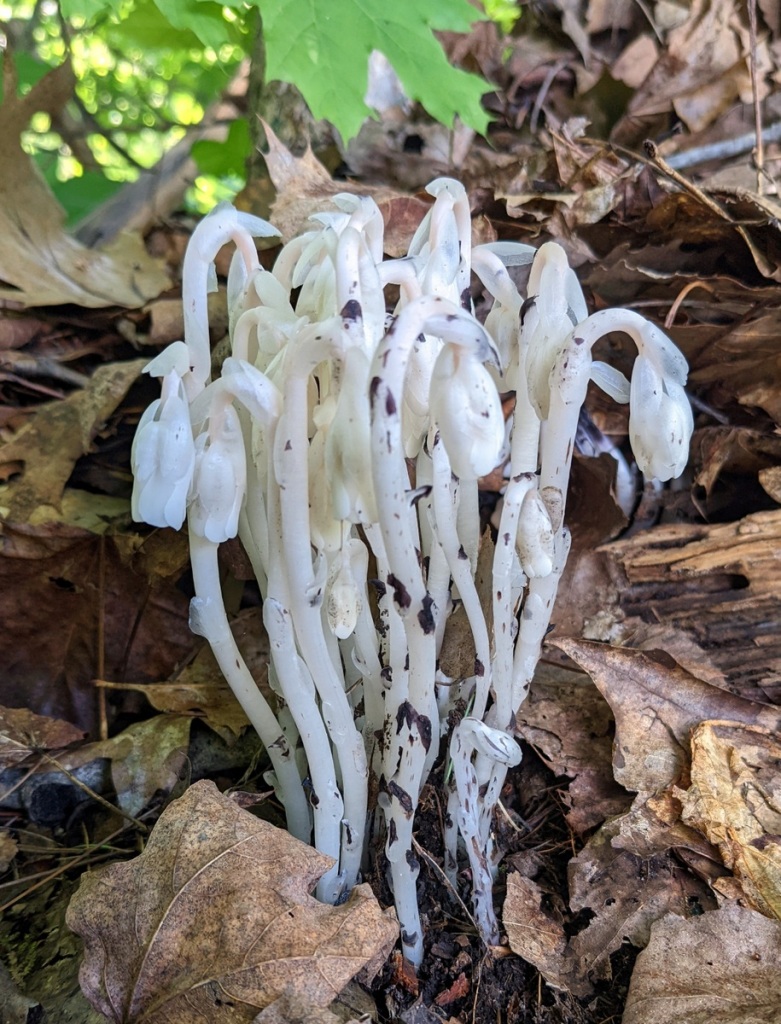
I know that Indian pipes (Monotropa uniflora) aren’t mushrooms but since they always appear along with mushrooms I usually include them in the same posts. It is fitting that the plant appears in a post on fungi because according to the University of Texas Indian pipes are associated with a fungus which obtains nutrients directly from the roots of green plants. That makes Indian pipe a parasite, with the fungus acting as a “bridge” between it and its host.

Another plant that is similar to Indian pipes is called pinesap (Monotropa hypopitys) It would be hard because of its color, to confuse these examples with Indian pipes but they can often be very light colored and can look the same at a glance. The surest way to know which plant you’re looking at is to count the flowers. The word uniflora in the scientific name of Indian pipes means “one flower” and that says it all; there is a single flower per stem. But on pinesap plants, as can be seen here, there are multiple flowers per stem. These plants receive nutrients from fungi that are associated with the roots of oaks and pines. They aren’t as common as Indian pipes so some years I don’t see them at all.

Hemlock varnish shelf fungi (Ganoderma tsugae) are probably the most easily found in this post. This was a good year for them and I saw trees with a dozen or more on them. Though they’re usually the size of saucers, I’ve seen them reach dinner plate size. This mushroom is considered the most important of all the herbs and substances used in Chinese herbal medicine, including ginseng. In China it is called the reishi mushroom and scientists around the world are researching its anti-cancer potential.

I’ve seen a lot of slime molds this year but almost all of them have been insect egg slime molds (Leocarpus fragilis) like that seen here. Each “egg,” about the same diameter as a common pin, is actually a fruiting body of the slime mold. Each one is on a stalk that can’t be seen here, and as they age they will blacken and harden, and start to crack open before releasing their spores to the wind.

In this view of another insect egg slime mold it has come together from the more liquid plasmodium stage and is in the process of separating into individual fruiting bodies. You can see just a few have separated out from the main mass. When finished the mass will look like what we just saw in the previous photo.

In this view of a slime mold taken earlier the slime mold is in the plasmodium stage, which happens before the stage in the previous photo. In this stage it is close to liquid and moves over the forest floor looking for yeasts, mushroom spores or bacteria to feed on. This movement is called “streaming” and happens at about 1 millimeter per hour. The plasmodium is made up of networks of protoplasmic veins and many nuclei which move to seek out food. Once the slime mold finds something it likes it comes together and surrounds it, and secretes enzymes to digest it. The easiest way for me to think of slime molds is as a single celled organism like an amoeba, with thousands of nuclei but in truth nobody can say what they really are. Though it can spread itself out over a large area the slime mold’s parts all move together as one, as a flock of birds or a school of fish would. They are fascinating and beautiful at the same time.
I have traveled backwards through a slime mold’s life cycle with these photos, so this photo would show stage one. Stage three, the final stage before spore production, would actually be two photos ago, if that makes sense.

I can’t swear to the fact and I have no scientific proof but experience has shown that when I see leaves colored in this way I am more likely to find slime molds; especially if the leaves are oak leaves.

The black tooth fungus (Phellodon niger) is easy to just pass by but it is an interesting mushroom that can vary in color. I’ve seen them almost black as these were and I’ve seen them in maroon. If they grow close enough together their caps can fuse together, creating a large misshapen mass. Of course they also grow singly. Another odd thing about this mushroom is how the caps seem to split open as they age. If you pick one you notice immediately how tough and dense it is; almost as if it has more weight than its size would permit. Finally, when it is turned over you see the black “teeth” that give it its common name. The teeth are really just folds of tissue and spores form on them. It’s interesting how the spore bearing surface increases when a mushroom grows pores or spines on its cap. All in all this ho-hum mushroom that people walk right by with hardly a glance really bears a second look, because it’s quite an interesting mushroom.

When I see a mushroom that looks like this I immediately think “chanterelle” but would I eat them? Not a chance. I’ve read and heard so many conflicting arguments for and against chanterelles and false chanterelles, summer chanterelles and winter chanterelles that I don’t know if I’d eat them even if an expert gave them their blessing. One of the most striking things about the mushroom in this photo is its hollow stem. But chanterelles have solid stems, right? Well, yes and no; yellow foot chanterelles have a hollow stem. In fact, DNA analysis has shown over 20 chanterelle species are at least partially hollow, and that’s just in the U.S., so the old solid stem argument doesn’t really hold water.

From the side this sure looks like a chanterelle but do we know the difference between false gills and true gills? Do the gills branch or do they run straight? Are they blunt where they meet the stem or do they just kind of fade? Are they the same color as the cap and stem? What color should the stem be?
Rather than trying to discourage anyone from eating mushrooms, I’m trying to show people what they should know so they can be sure what you’re eating is safe. In the case of chanterelles eating a big dish of false chanterelles won’t kill you, but it will make you sick enough to never want to do it again. The simple point is, know what you’re eating. If you can’t be 100% sure, don’t eat it; and that applies to not just mushrooms but any wild food. The best way to learn in my opinion, is to find someone who leads foraging hikes and tag along with them. You’ll learn more in an afternoon than you would have thought possible.

On the other hand, there are edible, choice mushrooms that you can be sure of just by their looks, and the purple trumpet (Craterellus cornucopioides) is one of those. I usually find them on south facing forested slopes under deciduous trees like beech, oak, and maple. They are also called black trumpets, blue trumpets, or blue chanterelles. They appear in this area near the end of August and are considered a delicacy. I’ve met foragers at this time of year whose first question is often “Have you seen any purple trumpets?” That’s because, if you walk into a restaurant kitchen with a bag full of these, you’ll likely walk out with a pocket full of cash, and that’s how professional foragers earn their living. Last I heard they were going for $50.00 per pound, but that was a couple of years ago I think. Purple trumpets are especially prized by chefs because they dry easily and they hold their flavor when dried, and they can be chopped, powdered or what have you. I’ve seen hillsides covered with so many of them you could hardly walk without stepping on them, but since I’m not a forager I just let them be.

Jelly babies (Leotia lubrica) helped me see that forests are full of small and beautiful things. Once you train your eyes to see small things, before long a previously unseen side of nature will suddenly appear. Despite their name jelly babies are sac fungi rather than jelly fungi.

I saw lots of red painted suillus mushrooms (Suillus spraguei) this year. For about a month they were everywhere I went. They are also called the painted slippery cap and red and yellow suillus. The caps are dark red when young and develop yellowish cracks as they age. They also have mats of reddish hairs on the cap as can be seen here.

Cotton like hairs on the underside of the painted suillus cap are actually a partial veil that covers the spore bearing surface when the mushroom is young.

In this shot taken previously you can see the yellowish elongated pores that are revealed when the partial veil pulls away. All of these features combined make this a very pretty mushroom that can indeed look like it was painted. These features also make it very easy to identify and the fact that it is a common mushroom makes it easy to find. That means it’s a good starting point in mushroom identification. They start to appear in mid-August and will be around through October, usually. Look for them near and under pines.

It’s hard to miss a Russell’s bolete (Boletellus russellii) if you look at its shaggy stem with its deep grooves and angular ridges. Why would a mushroom evolve a stem like this? The only thing I can guess is to impede slugs crawling up the stalk. The “yellow-brown to reddish-brown to olive-gray cap” is often scaly and sometimes cracked.

Though there are gilled boletes most have pores, as can be seen on the underside of a Russell’s bolete. The color or the surface is yellowish, becoming more yellow if it is bruised. You can see brighter yellow around the edges of the cap in this shot. The pores or tubes are very angular.

One recent morning I went out into the yard and found these crimson waxcaps (Hygrocybe punicea) under a hemlock tree at the edge of the forest. They were glowing with the light that is in all things, and I took several photos from different angles, trying to show you that glow. I do these mushroom posts in the hope that you’ll see their beauty more than their usefulness. To me they’re every bit as beautiful as flowers, but I’m noticing that people don’t seem to be as interested in mushroom posts as they once were. I thought the other day that if people could see nature just as it is before opinions and suppositions cloud their view, then they might discover the pure joy of seeing nature as a child does. If you’re lucky enough to have a two year old just walk through nature with them and watch and learn what seeing truly is, and what true joy and love are, and then find the child within yourself.
I love nature, I just don’t want to get any of it on me. ~Woody Allen
Thanks for coming by.



















































